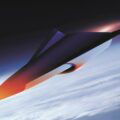Two symbols of the Cold War, nuclear explosions and U2 spy planes, combine in new storm research investigating the radioactive nature of lightning.
NASA satellites that are usually pointed at the stars detected something entirely unexpected coming from the Earth; gamma radiation bursts. Now, scientists are getting to the bottom of the decades-long mystery of those readings from the 1990s.
Discovering that thunderstorms were the cause of the bursts didn’t take long, but many questions remained. The scale and frequency of radioactive lightning storms were unknown. Existing satellites were designed to look for energy coming from space, not the Earth. Additionally, it was only happenstance if they were in the right time and place to collect what storm data they could.
From here, scientists turned to aerial collection platforms. Some found another, related strange phenomenon: dimly glowing gamma radiation emanating from clouds. These clouds had enough radioactive energy to glow, but for some unknown reason, there was no burst, only a simmer.
“A few aircraft campaigns tried to figure out if these phenomena were common or not, but there were mixed results, and several campaigns over the United States didn’t find any gamma radiation at all,” said Steve Cummer, of Duke University and coauthor on the two new research papers. “This project was designed to address these questions once and for all.”
A Renewed Effort to Understand Radioactive Lightning
The NASA ER-2 High-Altitude Airborne Science Aircraft, a U2 spy plane fitted with scientific instrumentation, provided a group of scientists with optimal tools that had long been lacking. Flying twice as high as a commercial plane, they were able to find vantage points well above any storms. Its tremendous speed also aided their research, as they were able to catch up with any storm they wished.
Their discovery: gamma radiation is much more common in thunderstorms than previously believed. Nine out of ten flights off the southern coast of Florida found low-level simmering gamma radiation in the storm they were observing. They focused on offshore storms for their increased intensity, a subject that The Debrief has previously covered. Additionally, despite the stable appearance of the glow, data illustrated an unexpectedly dynamic roil of gamma radiation.
“There is way more going on in thunderstorms than we ever imagined,” Cummer explained. “As it turns out, essentially all big thunderstorms generate gamma rays all day long in many different forms.”
Gamma Creation and Lightning
How lighting can generate radiation is not a mystery. Small elements of water in droplets or ice rub against each other in the swirl of a storm, generating electricity. As positive ions rise in the storm and negative ones fall, they generate a massive electric field. This field, in turn, accelerates any stray electrons that wander into it. The acceleration is so great that when these electrons collide with air molecules, they generate nuclear reactions, giving rise to gamma rays, antimatter, and more.
The question is, what does this unexpected gamma behavior mean for established storm physics? The team theorizes that the simmering gamma may be similar to steam, releasing energy from the storm so it doesn’t collect too much. Adding to the nuclear mystery, two types of gamma bursts were recorded for the first time. Dubbed “flickering gamma flash,” one lasted only a thousandth of a second, with the other operating on a sequence of ten bursts over a tenth of a second. Despite the rapid-fire nature of these gamma explosions, scientists say they aren’t dangerous to humans. The many known dangers of flying through a thundercloud from turbulence and wind eclipse the minuscule amount of gamma radiation.
The paper “Flickering Gamma-Ray Flashes, the Missing Link between Gamma Glows and TGFs” was published in Nature on October 2, 2024.
Ryan Whalen covers science and technology for The Debrief. He holds a BA in History and a Master of Library and Information Science with a certificate in Data Science. He can be contacted at ryan@thedebrief.org, and follow him on Twitter @mdntwvlf.

